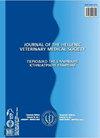Occurrence and molecular characterization of Salmonella Typhimurium and Salmonella Enteritidis isolates from contaminated food samples from Palestine
IF 0.4
4区 农林科学
Q4 VETERINARY SCIENCES
引用次数: 0
Abstract
Salmonella is one of the most frequently isolated foodborne pathogens. It is of major public health concern worldwide. Poultry meat and eggs represent an important source of Salmonellae organism for consumer health. This study aimed to evaluate the occurrence of Salmonella enterica serotype Typhimurium and Enteritidis using multiplex PCR (mPCR) among isolates collected from the local market and to assess genetic relationships between isolates of S. Typhimurium, which was the only serotype isolated from the tested food samples. This was done using virulence factors profiling and fingerprint profiling by random amplified polymorphic DNA (RAPD-PCR) and repetitive sequence PCR (REP-PCR) using enterobacterial repetitive intergenic consensus (ERIC-PCR) and interspersed repetitive DNA sequence BOXAIR-PCR. The overall occurrence percentage of S. Typhimurium and S. Enteritidis out of 51 isolates was 54.9% and 0.0%, respectively. Only 13 out of 17 virulence genes were detected in these isolates. The occurrence of the detected virulence genes among these isolates was 100%, 50.0%,46.4%, 39.3%, 35.7%, 35.7%, 32.1%, 25.0%, 25.0%, 17.6%, 14.3%, 14.3%, 3.6% for invA, sopB, prgH, sitC, pefA, tolC, cdtB, msgA, sifA, iroN, spiA, ipfC and pagC, respectively. The remaining virulence genes were absent in all of the isolates. Based on the combination of the presence and absence of virulence genes, eight profiles were detected among these isolates, the most common genetic profile was V5 (each 32.1%). Based on this genetic profile at cut-off point 96.0%, both ERIC and BOX primers allowed for discrimination into 4 and 6 clusters or clones of 16 S. Typhimurium isolates, respectively. Results of PCR typing methods showed that, three strains clustered together using both ERIC-PCR and BOX-PCR typing methods and they had the same virulotype (V1), while other four strains also clustered together by both typing methods and had the same virulotype (V8). Contamination of food with Salmonellae especially with S. Typhimurium was high and indicated a bad microbiological quality of food. This emphasizes the need for rigorous public health and food safety methods to lower the human health hazard and risk associated with Salmonellae infection.巴勒斯坦受污染食品中鼠伤寒沙门菌和肠炎沙门菌分离株的发生及分子特征分析
沙门氏菌是最常分离的食源性病原体之一。它是全世界关注的主要公共卫生问题。禽肉和禽蛋是沙门氏菌对消费者健康的重要来源。本研究旨在利用多重PCR (multiple PCR, mPCR)技术对从当地市场采集的分离株进行鼠伤寒沙门菌和肠炎沙门菌血清型的发生情况进行评估,并评估从食品样品中分离到的唯一血清型鼠伤寒沙门菌的遗传关系。采用随机扩增多态性DNA (RAPD-PCR)和重复序列PCR (REP-PCR)进行毒力因子分析和指纹图谱分析,使用肠杆菌重复基因间一致性(ERIC-PCR)和穿插重复DNA序列BOXAIR-PCR。51株鼠伤寒沙门氏菌和肠炎沙门氏菌总检出率分别为54.9%和0.0%。在这些分离株中仅检测到17个毒力基因中的13个。invA、sopB、prgH、sitC、pefA、tolC、cdtB、msgA、sifA、iroN、spiA、ipfC、pagC的毒力基因检出率分别为100%、50.0%、46.4%、39.3%、35.7%、35.7%、32.1%、25.0%、25.0%、17.6%、14.3%、14.3%、3.6%。其余毒力基因均不存在。结合毒力基因的存在和缺失,在这些分离物中检测到8个基因型,最常见的基因型是V5(占32.1%)。基于截断点96.0%的遗传图谱,ERIC和BOX引物分别可将16株鼠伤寒沙门氏菌分离物区分为4个和6个聚类或克隆。PCR分型结果显示,ERIC-PCR分型和BOX-PCR分型均有3株聚集在一起,病毒型相同(V1),其余4株也均聚集在一起,病毒型相同(V8)。食品中沙门氏菌特别是鼠伤寒沙门氏菌的污染程度较高,表明食品微生物质量较差。这强调需要采取严格的公共卫生和食品安全方法,以降低与沙门氏菌感染有关的人类健康危害和风险。
本文章由计算机程序翻译,如有差异,请以英文原文为准。
求助全文
约1分钟内获得全文
求助全文
来源期刊

Journal of the Hellenic Veterinary Medical Society
VETERINARY SCIENCES-
CiteScore
0.60
自引率
0.00%
发文量
83
审稿时长
>12 weeks
期刊介绍:
The Journal of the Hellenic Veterinary Medical Society (J Hellenic Vet Med Soc) is a quarterly peer-reviewed journal that publishes articles in all aspects of veterinary science and related disciplines. It is published by the Hellenic Veterinary Medical Society and is indexed in the Web of Science and in Scopus.
There are no publication fees in the journal. Authors considering submitting manuscripts for evaluation and publication are requested to read carefully the instructions for authors and fully comply with them.
Non-complying manuscripts may be returned to the corresponding author for formatting.
 求助内容:
求助内容: 应助结果提醒方式:
应助结果提醒方式:


